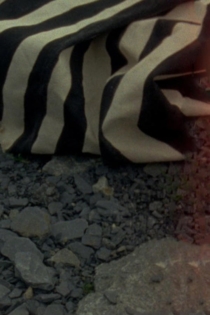
Beatrice Gibson
2021Agatha
Beatrice Gibson
A psychosexual sci-fi about a planet without speech. Its narrator, ambiguous in gender and function, weaves us slowly through a mental and physical landscape, observing and chronicling a space beyond words. Based on a dream had by the radical British composer Cornelius Cardew.
Agatha

I Hope I'm Loud When I'm Dead
Beatrice Gibson
Beatrice Gibson, CAConrad
Reframing our current political moment in intimate terms, Gibson’s urgent snapshot of worldwide social calamities doubles as a document of practical resistance. In Gibson’s hands, the music of Pauline Oliveros and the words of poets CA Conrad and Eileen Myles imbue images of street riots, the Grenfell Fire, and the mass refugee migration with complexity and grace.
I Hope I'm Loud When I'm Dead

The Tiger's Mind
Beatrice Gibson
An abstract crime thriller set against the backdrop of a brutalist villa. Six characters, the set, the music, the foley, the special effects, the narrator and the author battle one another for control of the film as it unfolds on screen. The film explores the relationships between these characters as they emerge and unfold: grappling, wrestling, and dreaming with one another. The film's production elements were produced - employing the character-driven improvisational score The Tiger's Mind, by Cornelius Cardew - by Alex Waterman as Tree (foley), Jesse Ash as Wind (special effects), John Tilbury as Mind (soundtrack), Celine Condorelli as Tiger (props), Will Holder as Amy (narrator) and Beatrice Gibson as the Circle (author).
The Tiger's Mind

F for Fibonacci
Beatrice Gibson
Clay Barnard Chodzko
F for Fibonacci is a new film that takes as its departure point American author William Gaddis’ epic modernist novel JR (1975). An eerily prescient, biting social satire, JR tells the story of a precocious 11 year-old capitalist who, with the unwitting help of his school’s resident composer, inadvertently creates the single greatest virtual empire the world has seen, spun largely from the anonymity of the school’s pay phone. F for Fibonacci develops a particular episode from JR, in which a televised music lesson is scrambled with a maths class on derivatives inside the mind of its child protagonist. Musings on aleatory music become muddled with virtual stock pickings and a theory of ‘market noise’. Unfolding through the modular machine aesthetics of the video game Minecraft, text book geometries, graphic scores, images from physics experiments, and cartoon dreams, blend with images from wall street: stock market crashes, trading pits, algorithms and transparent glass.
F for Fibonacci

Deux Soeurs Qui Ne Sont Pas Soeurs
Beatrice Gibson
Adam Christensen, Basma Alsharif
Based on Gertrude Stein’s eponymously named screenplay, written in 1929 as European fascism was building momentum. Beatrice Gibson’s adaptation, set almost a century later in contemporary Paris, deploys Stein’s script as a talismanic guide through a contemporary moment of comparable social and political unrest. An original soundtrack, written especially for the film by British composer Laurence Crane, responds to the repetition, duplication and duality at play in Stein’s script. Both a fictional thriller and an act of collective representation, Deux Soeurs proposes empathy and friendship as means to reckon with an increasingly turbulent present.
Two Sisters Who Are Not Sisters

A Necessary Music
Beatrice Gibson
A collaboration between artist Beatrice Gibson and composer Alex Waterman, A Necessary Music is a science fiction film about modernist social housing. A musically conceived piece, referencing the video operas of Robert Ashley, the film explores the social imaginary of a utopian landscape through directed attention to the voices that inhabit it.Treating the medium of film as both a musical proposition and a proposal for collective production, A Necessary Music employs the resident of New York’s Roosevelt Island as its authors and actors, gathering together texts written by them and using them to construct a script for the film. Framed by a fictional narration taken from Adolfo Bioy Casares’ 1941 science fiction novel ‘The invention of Morel’, the film self-consciously dissolves from attempted realism to imagined narrative; what begins as a enthnographic study becomes instead an imagined fiction and an investigation into the mechanics of representation itself.
A Necessary Music
